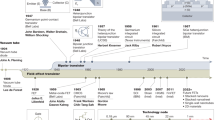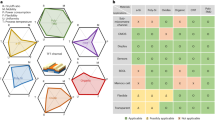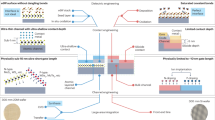Abstract
Complementary field-effect transistors—which have n-type and p-type field-effect transistors (FETs) vertically stacked on top of each other—can boost area efficiency in integrated circuits. However, silicon-based complementary FETs suffer from several issues, including difficulty in balancing electron and hole mobility. Here we report heterogeneous complementary FETs that combine p-type FETs made with silicon-on-insulator technology and n-type FETs made with two-dimensional molybdenum disulfide (MoS2). Through mobility matching and multiple-gate modulation of the MoS2, the mobility mismatch issue of fully silicon-based systems can be addressed. Our integration approach leverages the maturity of the silicon process, the low thermal budget of MoS2 and the low aspect ratio of the device structures to reduce process complexity and device degradation. We use the approach to create a complementary FET inverter that exhibits a voltage gain of 142.3 at a supply voltage of 3 V, and a voltage gain of 1.2 and power consumption of 64 pW at a supply voltage of 100 mV. We also develop a four-inch fabrication process for the silicon–two-dimensional complementary FETs.
This is a preview of subscription content, access via your institution
Access options
Access Nature and 54 other Nature Portfolio journals
Get Nature+, our best-value online-access subscription
$29.99 / 30 days
cancel any time
Subscribe to this journal
Receive 12 digital issues and online access to articles
$119.00 per year
only $9.92 per issue
Buy this article
- Purchase on Springer Link
- Instant access to full article PDF
Prices may be subject to local taxes which are calculated during checkout




Similar content being viewed by others
Data availability
The data that supports the findings of this study are available at https://zenodo.org/record/7241056#.Y1UBsXZBxPY. All other data are available from the corresponding authors upon reasonable request.
Code availability
The codes used for simulation and data plotting are available from the corresponding authors upon reasonable request.
References
Desai, S. B. et al. MoS2 transistors with 1-nanometer gate lengths. Science 354, 99–102 (2016).
Wu, F. et al. Vertical MoS2 transistors with sub-1-nm gate lengths. Nature 603, 259–264 (2022).
Liao, F. et al. Bioinspired in-sensor visual adaptation for accurate perception. Nat. Electron. 5, 84–91 (2022).
Liu, C. et al. Small footprint transistor architecture for photoswitching logic and in situ memory. Nat. Nanotechnol. 14, 662–667 (2019).
Mennel, L. et al. Ultrafast machine vision with 2D material neural network image sensors. Nature 579, 62–66 (2020).
Wachter, S. et al. A microprocessor based on a two-dimensional semiconductor. Nat. Commun. 8, 14948 (2017).
Waltl, M. et al. Perspective of 2D integrated electronic circuits: scientific pipe dream or disruptive technology? Adv. Mater. 2201082 (2022).
Zhu, K. et al. The development of integrated circuits based on two-dimensional materials. Nat. Electron. 4, 775–785 (2021).
Liu, Y. et al. Promises and prospects of two-dimensional transistors. Nature 591, 43–53 (2021).
Akinwande, D. et al. Graphene and two-dimensional materials for silicon technology. Nature 573, 507–518 (2019).
Milana, S. The lab-to-fab journey of 2D materials. Nat. Nanotechnol. 14, 919–921 (2019).
Sachid, A. B. et al. Monolithic 3D CMOS using layered semiconductors. Adv. Mater. 28, 2547–2554 (2016).
Fiori, G. et al. Electronics based on two-dimensional materials. Nat. Nanotechnol. 9, 768–779 (2014).
Shen, P.-C. et al. Ultralow contact resistance between semimetal and monolayer semiconductors. Nature 593, 211–217 (2021).
Li, T. et al. Epitaxial growth of wafer-scale molybdenum disulfide semiconductor single crystals on sapphire. Nat. Nanotechnol. 16, 1201–1207 (2021).
Wang, J. et al. Dual-coupling-guided epitaxial growth of wafer-scale single-crystal WS2 monolayer on vicinal a-plane sapphire. Nat. Nanotechnol. 17, 33–38 (2022).
Kang, K. et al. High-mobility three-atom-thick semiconducting films with wafer-scale homogeneity. Nature 520, 656–660 (2015).
O’Brien, K. P. et al. Advancing 2D monolayer CMOS through contact, channel and interface engineering. In IEEE International Electron Devices Meeting 7.1.1–7.1.4 (IEEE, 2021).
Kang, K. et al. Layer-by-layer assembly of two-dimensional materials into wafer-scale heterostructures. Nature 550, 229–233 (2017).
Li, N. et al. Large-scale flexible and transparent electronics based on monolayer molybdenum disulfide field-effect transistors. Nat. Electron. 3, 711–717 (2020).
Wu, S. et al. High-performance p-type MoS2 field-effect transistor by toroidal-magnetic-field controlled oxygen plasma doping. 2D Mater. 6, 025007 (2019).
Lee, C. et al. Anomalous lattice vibrations of single- and few-layer MoS2. ACS Nano 4, 2695–2700 (2010).
Parker, J. J. et al. Raman scattering by silicon and germanium. Phy. Rev. 155, 712–714 (1967).
Sebastian, A. et al. Benchmarking monolayer MoS2 and WS2 field-effect transistors. Nat. Commun. 12, 693 (2021).
Badaroglu, M. et al. in Bardaroglu, M. (ed.) IEEE International Roadmap for Devices and Systems 2021, 13 (IEEE, 2021); https://irds.ieee.org/images/files/pdf/2021/2021IRDS_MM.pdf
Shokouh, S. H. H. et al. High-gain subnanowatt power consumption hybrid complementary logic inverter with WSe2 nanosheet and ZnO nanowire transistors on glass. Adv. Mater. 27, 150–156 (2015).
Yu, L. et al. High-performance WSe2 complementary metal oxide semiconductor technology and integrated circuits. Nano Lett. 15, 4928–4934 (2015).
Jeon, P. J. et al. Low power consumption complementary inverters with n-MoS2 and p-WSe2 dichalcogenide nanosheets on glass for logic and light-emitting diode circuits. ACS Appl. Mater. Interfaces 7, 22333–22340 (2015).
Sheng, Y. et al. Gate stack engineering in MoS2 field-effect transistor for reduced channel doping and hysteresis effect. Adv. Electron. Mater. 7, 2000395 (2020).
Xu, H. et al. High-performance wafer-scale MoS2 transistors toward practical application. Small 14, 1803465 (2018).
Uchida, K. et al. Experimental study on electron mobility in ultrathin-body silicon-on-insulator metal-oxide-semiconductor field-effect transistors. J. Appl. Phys. 102, 074510 (2007).
Yokoyama, M. et al. Ultrathin body InGaAs-on-insulator metal-oxide-semiconductor field-effect transistors with InP passivation layers on Si substrates fabricated by direct wafer bonding. Appl. Phys. Express 4, 054202 (2011).
Chang, S. W. et al. First demonstration of heterogeneous IGZO/Si CFET monolithic 3D integration with dual workfunction gate for ultra low-power SRAM and RF application. In IEEE International Electron Devices Meeting 34.4.1–34.4.4 (IEEE, 2021).
Ma, J. et al. Top gate engineering of field-effect transistors based on wafer-scale two-dimensional semiconductors. J. Mater. Sci. Technol. 106, 243–248 (2022).
Li, K. S. et al. Negative-capacitance FinFET inverter, ring oscillator, SRAM cell, and Ft. In IEEE International Electron Devices Meeting 31.7.1–31.7.4 (IEEE, 2018).
Chang, S. W. et al. First demonstration of CMOS inverter and 6T-SRAM based on GAA CFETs structure for 3D-IC applications. In IEEE International Electron Devices Meeting 11.7.1–11.7.4 (IEEE, 2019).
Zhang, S. et al. Wafer-scale transferred multilayer MoS2 for high performance field effect transistors. Nanotechnology 30, 174002 (2019).
Koenig, S. P. et al. Electron doping of ultrathin black phosphorus with Cu adatoms. Nano Lett. 16, 2145–2151 (2016).
Yu, L. et al. Design, modeling, and fabrication of chemical vapor deposition grown MoS2 circuits with E-mode FETs for large-area electronics. Nano Lett. 16, 6349–6356 (2016).
Liu, T. et al. Nonvolatile and programmable photodoping in MoTe2 for photoresist-free complementary electronic devices. Adv. Mater. 30, 1804470 (2018).
Radisavljevic, B. et al. Mobility engineering and a metal-insulator transition in monolayer MoS2. Nat. Mater. 12, 815–820 (2013).
Fuhrer, M. S. et al. Measurement of mobility in dual-gated MoS2 transistors. Nat. Nanotechnol. 8, 146–147 (2013).
Fiori, G. et al. Velocity saturation in few-layer MoS2 transistor. Appl. Phys. Lett. 103, 233509 (2013).
Szafranek, B. N. et al. Current saturation and voltage gain in bilayer graphene field effect transistors. Nano Lett. 12, 1324–1328 (2012).
Fang, H. et al. High-performance single layered WSe2 p-FETs with chemically doped contacts. Nano Lett. 12, 3788–3792 (2012).
Cho, S. et al. Insulating behavior in ultrathin bismuth selenide field effect transistors. Nano Lett. 11, 1925–1927 (2011).
Li, L. et al. Black phosphorus field-effect transistors. Nat. Nanotechnol. 9, 372–377 (2014).
Si, M. et al. Scaled indium oxide transistors fabricated using atomic layer deposition. Nat. Electron. 5, 164–170 (2022).
Guo, Y. et al. Eighteen functional monolayer metal oxides: wide bandgap semiconductors with superior oxidation resistance and ultrahigh carrier mobility. Nanoscale Horiz. 4, 592–600 (2019).
Acknowledgements
We acknowledge financial support from the National Key R&D Program of China (No. 2021YFA1200500), the Innovation Program of Shanghai Municipal Education Commission (no. 2021-01-07-00-07-E00077), the Shanghai Municipal Science and Technology Commission (no. 1DZ1100900), the Shanghai Science and Technology Commission ‘Explorer Project’ under Grant 21TS1401300, Guangdong Province Research and Development in Key Fields from Guangdong Greater Bay Area Institute of Integrated Circuit and System(No.2021B0101280002) and Guangzhou City Research and Development Program in Key Field (No.20210302001). We also thank the support by the young scientist project of the MOE innovation platform.
Author information
Authors and Affiliations
Contributions
J.W., W.B. and P.Z. conceived and supervised the project. L.T. wrote the manuscript, and J.W., W.B. and P.Z. revised the manuscript. K.X. and J.L. fabricated the SOI pFET and L.T. performed the rest of the CFET fabrication. L.T. performed the electrical and optoelectronic measurements and data processing with assistance from J.M. K.X. and J.L. performed the gas measurements. J.M. and X.G. performed the Raman spectra and photoluminescence spectra characterizations. L.Z. and S.D. performed the transmission electron microscopy characterization and analysis. Z.X. performed CVD growth and a part of transfer work of MoS2. J.W., K.X. and J.L. contributed to the technology computer-aided design simulation. All authors contributed to discussions.
Corresponding authors
Ethics declarations
Competing interests
The authors declare no competing interests.
Peer review
Peer review information
Nature Electronics thanks Xiangbin Zeng and the other, anonymous, reviewer(s) for their contribution to the peer review of this work.
Additional information
Publisher’s note Springer Nature remains neutral with regard to jurisdictional claims in published maps and institutional affiliations.
Supplementary information
Supplementary Information
Supplementary Figs. 1–35, Notes 1–3, and Tables 1 and 2.
Rights and permissions
Springer Nature or its licensor (e.g. a society or other partner) holds exclusive rights to this article under a publishing agreement with the author(s) or other rightsholder(s); author self-archiving of the accepted manuscript version of this article is solely governed by the terms of such publishing agreement and applicable law.
About this article
Cite this article
Tong, L., Wan, J., Xiao, K. et al. Heterogeneous complementary field-effect transistors based on silicon and molybdenum disulfide. Nat Electron 6, 37–44 (2023). https://doi.org/10.1038/s41928-022-00881-0
Received:
Accepted:
Published:
Issue Date:
DOI: https://doi.org/10.1038/s41928-022-00881-0



